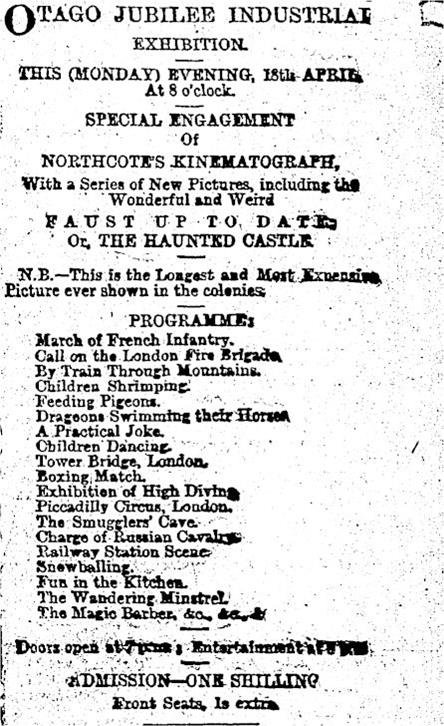
On 13 October 1896, New Zealanders first got their chance to see moving pictures, when the first film was played to an audience at the Opera House in Auckland. Ngā Taonga Sound & Vision is marking this anniversary with a series of screenings of a selection of Films that Shaped New Zealand in Wellington over the next 10 days – and we will be preceding each of these screenings by showing either Sandow the Strong Man or The Serpentine Dance before each feature. These were two of the first films ever watched by New Zealand audiences back in 1896.
Hero image: Still from The Serpentine Dance.
Eugen Sandow in the 'Sandow the Strongman', 1894.
The inaugural screening of moving pictures in New Zealand was as part of a vaudeville programme by Charles Godfrey’s Vaudeville Company. The “kinematograph” screenings were part of the show’s line-up, along with singers and musical items. After the first performances in Auckland, the show moved to Thames, Paeroa and Wellington later in October 1896, before further screenings in Christchurch and Dunedin in November that year.

Newspaper article about the first motion picture screening in New Zealand. (New Zealand Herald, 13 October 1896. (courtesy of Papers Past)
Annabelle Whitford in the 'The Serpentine Dance',1895.
Sandow the Strongman (featuring pioneering German bodybuilder Eugen Sandow), and The Serpentine Dance (starring Ziegfield Follies dancer Anabelle Moore Whitford), were two of a series of short silent films which had been created by Thomas Edison’s company in the United States to highlight the new motion picture technology. All of these first films are full of movement: a dancer in a flowing and voluminous dress, a strongman striking athletic poses, a train pulling into the station, beach and street scenes full of walking people.
A reviewer writing in the New Zealand Herald the day after the first screening was impressed:
“Everything moved as though in life; in fact, it was life reproduced.” – New Zealand Herald, 14 October 1896
Soon after the first screenings in Wellington, the Evening Post wrote:
“An electric knob is touched, and where all was darkness there appears an illumination, and Sandow ‘the strong man,’ not a picture, but Sandow in his habit as he lives, displaying every feature of his marvellous muscular power… every twist and twitch… every expression of his face… is reproduced with absolute fidelity to nature” – Evening Post, 27 October 1896
A sound recording from Ngā Taonga Sound & Vision’s radio collection recalls the audience reaction when motion pictures came to rural Southland a couple of years later, in 1899. Marion Rowe was 9 years old at the time. In this recording she explains how moving pictures were shown to her community as part of an evening’s entertainment. This included magic lantern slides (projections of still images) and Edison’s other new invention, the phonograph – the first time recorded sound had been heard there. She remembers after the film screening:
“The men gathered around the machine, eager to see how it worked – just as in a few years’ time, they would be found with their heads under the bonnet of a car… The women talked it over. The general consensus was that now they could believe anything.”
Excerpt from'Marian Rowe on Magic Lanterns, a Phonograph and Moving Picture Show', 1964.
In her commentary, Marion describes watching two films: one a slapstick, silent comedy called Fun in the Kitchen, and the other, footage filmed from the front of a train, which we think was probably an item called By Train through the Mountains. We don’t know who produced these items, but they appear to have been part of a programme of films that was screened in Otago and Southland in 1898-1899, as this newspaper advertisement shows:

Article from the Otago Daily Times, 18 April 1898. (courtesy of Papers Past)
The popularity of moving pictures meant they soon got off the vaudeville circuit and became established as a form of entertainment in their own right. Permanent theatres began to appear around the country and screenings became more ambitious, with sound effects added in the theatre, as well as piano or orchestra accompaniment.
Another sound recording in our archival collections emphasises that watching silent films was anything but silent. In 1968, Alwyn Owen (later a producer of RNZ’s “Spectrum” documentaries) interviewed many men and women who were involved in the early days of cinema and compiled their memories into a radio documentary called A Silence filled with Sound.
As well as recollections of the challenges faced by projectionists working with highly flammable nitrate film, this man recalled that children were often employed to hand-crank the projectors.
'A Silence Filled with Sound', 1983. (Spectrum 446)
Silent film accompanists and orchestras played an important part in the early cinema-going experience. Often the selection of the music chosen to evoke the right emotions in the audience was left up to them. Violet Capstick Donaldson of Timaru was a theatre pianist for 22 years from the 1900s. She recalls in this interview how she would choose the sad songs such as “Hearts and Flowers” to match tragic scenes on the screen.